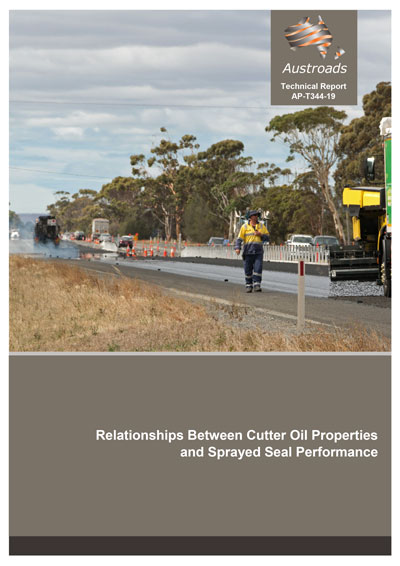Pavement

- Publication no: AP-T344-19
- ISBN: 978-1-925854-19-0
- Published: 20 November 2019
- Edition: 1.1
- PDF (free) Download
This study investigated the relationship between cutter oil properties and sprayed seal performance so that this information could be used as a basis for updating Australian Standard 3568. AS 3568 specifies the properties of four different types of oils which can be used to reduce the viscosity of binders during sprayed seal construction. The standard has not been updated since 1999 and needs to be revised to be more performance-based so that it can include currently available commercial products.
During the study, seven commercially available oils were initially subjected to a range of currently specified AS 3568 tests. The results obtained for each oil were then compared to the results obtained in four different laboratory sprayed seal performance tests which were performed after each of the oils had been blended with a single sample of C170 bitumen. Correlations were found between the AS 3568-specified final boiling point and viscosity at 40 °C results obtained for each of the neat oils, and the results obtained in the laboratory performance tests.
A number of changes to AS 3568 have been proposed based on the results obtained in the study and input from the Austroads.
Edition 1.1 corrects the density property in Table 9.1 Proposed revised specification table for cutter oil and high flash point cutter.
Edition 1.1 published November 2019, corrects the density property in Table 9.1 Proposed revised specification table for cutter oil and high flash point cutter.
Edition 1.0 published June 2019.
- Summary
- 1. Introduction
- 2. Cutter Specifications Used in Australia and Overseas
- 2.1 Australian Specifications for Oils Used to Reduce the Viscosity of Binders
- 2.1.1 Current AS 3568 Specification Requirements and Associated Test Methods
- 2.1.2 Australian Jurisdiction Specifications for Oils to Reduce the Viscosity of Binders
- 2.2 International Specifications for Oils Used to Reduce the Viscosity of Binders
- 2.2.1 New Zealand
- 2.2.2 South Africa
- 2.2.3 USA
- 2.2.4 European Union
- 2.3 Summary
- 2.1 Australian Specifications for Oils Used to Reduce the Viscosity of Binders
- 3. Previous Research into the Performance of Cutters in Sprayed Seals
- 3.1 Initial Research (1950s and 1960s)
- 3.2 Research Conducted Since the 1980s
- 3.2.1 Road Trials Investigating Cutter Loss Over Time
- 3.2.2 Investigations of Cutter Loss During Spraying
- 3.2.3 Laboratory Studies of Cutter Loss from Binder Films
- 3.2.4 Laboratory Studies of Bitumen Viscosity Reduction Due to the Use of Different Cutters
- 3.2.5 Aggregate Wetting Tests
- 3.3 Summary and Tests Included in the Current Study
- 4. Neat Bitumen and Oil Properties
- 4.1 C170 Bitumen Properties
- 4.2 Neat Oil Properties
- 4.2.1 AS 3568‑related Test Results
- 4.2.2 Comparisons of Boiling Point Behaviour
- 4.2.3 Chemical Characterisation Tests
- 4.3 Summary
- 5. Stability of Oil Blends with C170 Bitumen
- 5.1 Bitumen‑oil Blend Preparation
- 5.2 Stability Tests
- 6. Mass Loss Tests
- 6.1 Mass Loss Test Experimental Design
- 6.1.1 Adding Appropriate Amounts of Binder to Metal Dishes
- 6.1.2 Binder Film Formation
- 6.1.3 Mass Loss Tests
- 6.2 Mass Loss Test Results
- 6.2.1 C170 Bitumen Film Results
- 6.2.2 Results Obtained from Films Containing C170 Bitumen and Oil
- 6.3 Mass Loss Test Data Analysis
- 6.3.1 Comparisons of Amounts of Oil Loss with Films Containing Jet A1
- 6.3.2 Comparisons with Neat Oil Boiling Point Behaviour
- 6.3.3 Comparisons with AS 3568‑specified Chemical Properties of the Neat Oils
- 6.4 Changes in Binder Viscosity During Mass Loss Tests
- 6.5 Summary
- 6.1 Mass Loss Test Experimental Design
- 7. Viscosity Tests
- 7.1 DSR and Brookfield Viscosity Test Experimental Protocols
- 7.2 Master‑curve Fitting of DSR Test Results
- 7.3 Comparisons Between Bitumen‑oil Blend Viscosity Results and Neat Oil Properties
- 7.4 Effects of the Use of Different Oils on AP‑T39‑05 Recommended Cutter Levels
- 7.4.1 Complex Viscosity Results Obtained for C170 Bitumen‑Jet A1 Blends at AP‑T39‑05 Recommended Levels
- 7.4.2 Matched Complex Viscosity Results for Other C170 Bitumen‑oil Blends
- 7.4.3 AS 3568 Specification Implications
- 7.5 Comparisons Between DSR Complex Viscosity and Brookfield Viscosity Results
- 7.6 Summary
- 8. Aggregate Wetting Tests
- 8.1 Aggregate Wetting Test Experimental Design
- 8.2 Aggregate Wetting Test Results
- 8.3 Summary
- 9. Proposed Changes to AS 3568
- 9.1 Observed Correlations between AS 3568‑specified Test Properties and Sprayed Seal Performance
- 9.2 Review of Other AS 3568‑specified Test Properties
- 9.2.1 Density at 15 °C
- 9.2.2 Flash Point
- 9.2.3 Miscibility
- 9.2.4 Fluidity and Water Content
- 9.3 AS 3568 Clause 3 Definitions
- 9.4 Proposed Modifications to an Updated Version of AS 3568
- 9.5 AS 3568 Update Status
- 10. Summary and Conclusions
- References
- Appendix A Mass Loss Results Not Included in the Main Body of the Report
- Appendix B DSR Results not Included in the Main Body of the Report
- Appendix C Aggregate Wetting Results Not Included in the Main Body of the Report
